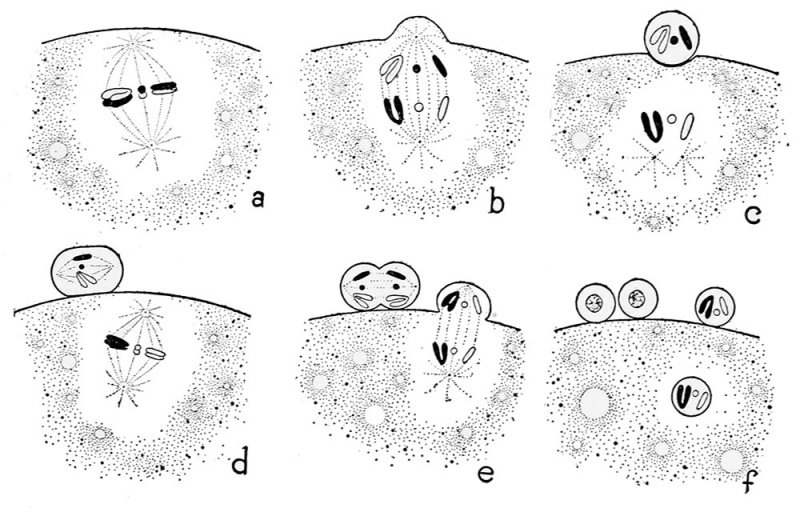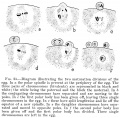File:Morgan 1925 fig35.jpg

Original file (1,000 × 645 pixels, file size: 146 KB, MIME type: image/jpeg)
Fig. 35. Diagram illustrating the two maturation divisions of the egg
In a the polar spindle is present at the periphery of the egg. The three pairs of chromosomes (bivalents) are represented in black and white; the white being the paternal and the black the maternal. In b the conjugating chromosomes have separated and are moving to the poles. In c the first polar body has been given off, leaving three single chromosomes in the egg. In c these have split lengthwise and lie off the equator of a new spindle. In e the daughter chromosomes have separated and moved to opposite poles. In / the second polar body has been given off and the first polar body has divided. Three single chromosomes are left in the egg.
| Historic Disclaimer - information about historic embryology pages |
|---|
| Pages where the terms "Historic" (textbooks, papers, people, recommendations) appear on this site, and sections within pages where this disclaimer appears, indicate that the content and scientific understanding are specific to the time of publication. This means that while some scientific descriptions are still accurate, the terminology and interpretation of the developmental mechanisms reflect the understanding at the time of original publication and those of the preceding periods, these terms, interpretations and recommendations may not reflect our current scientific understanding. (More? Embryology History | Historic Embryology Papers) |
Reference
Morgan, T. H. (1925). Evolution and genetics. Princeton: Princeton University Press.
Cite this page: Hill, M.A. (2024, April 25) Embryology Morgan 1925 fig35.jpg. Retrieved from https://embryology.med.unsw.edu.au/embryology/index.php/File:Morgan_1925_fig35.jpg
- © Dr Mark Hill 2024, UNSW Embryology ISBN: 978 0 7334 2609 4 - UNSW CRICOS Provider Code No. 00098G
File history
Click on a date/time to view the file as it appeared at that time.
| Date/Time | Thumbnail | Dimensions | User | Comment | |
|---|---|---|---|---|---|
| current | 09:17, 23 October 2014 |  | 1,000 × 645 (146 KB) | Z8600021 (talk | contribs) | |
| 09:16, 23 October 2014 |  | 1,200 × 1,176 (309 KB) | Z8600021 (talk | contribs) |
You cannot overwrite this file.
File usage
The following 2 pages use this file:
